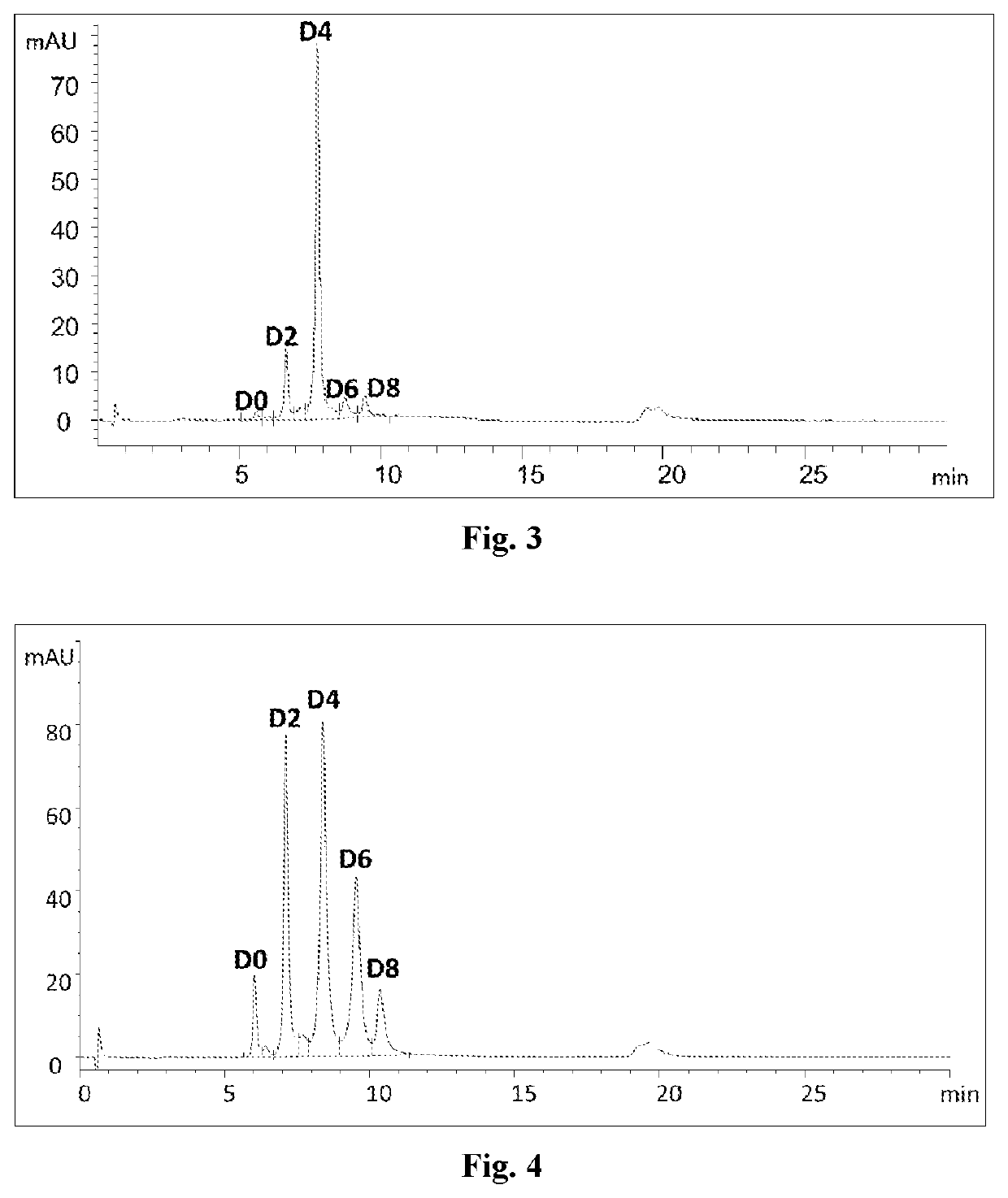Process for preparing antibody-drug conjugates with improved homogeneity
a technology of antibody-drug conjugates and homogeneity, which is applied in the field of bioconjugation process for preparing antibody-drug conjugates with improved homogeneity, can solve the problems of nhs ester application complicated purification and identification of free drugs after conjugation, and limited application of nhs ester in antibody-drug conjugate production. , to achieve the effect of improving homogeneity, simple manipulation and reduced
- Summary
- Abstract
- Description
- Claims
- Application Information
AI Technical Summary
Benefits of technology
Problems solved by technology
Method used
Image
Examples
example 1
on of Herceptin-MC-VC-PAB-MMAE Conjugate by Using the Process of the Present Disclosure and Homogeneity Thereof
[0229]The Herceptin-MC-VC-PAB-MMAE conjugate is prepared in a one-pot reaction:
(1) ZnCl2 (0.04 mM) and TCEP (0.08 mM) were added to a solution of Herceptin (produced in WuXi Biologics, according to the published corresponding protein sequences, via standard method for preparing monoclonal antibodies, 0.02 mM, in phosphate buffer, pH7, 20 mM) and the reaction mixture was allowed to stay at 4° C. overnight;
(2) MC-VC-PAB-MMAE (commercially available from Lenena, biopharma, 0.12 mM) in DMA (Dimethylacetamide, commercially available from Aldrich Sigma) was introduced and the reaction was continued at 4 C for 2 h;
(3) cysteine (0.08 mM) was added to deplete excessive MC-VC-PAB-MMAE;
(4) EDTA (0.08 mM) was added to trap Zn2 and DHAA (commercially available from Aldrich Sigma, 0.16 mM) was added to oxidize the excessive thiol groups;
(5) the reaction mixture was subjected to purificat...
example 2
on of Rituxan-MC-VC-PAB-MMAE Conjugate by Using the Process of the Present Disclosure and Homogeneity Thereof
[0233]The Rituxan-MC-VC-PAB-MMAE conjugate is prepared in a one-pot reaction:
(1) ZnCl2 (0.04 mM) and TCEP (0.08 mM) were subsequently added to a solution of Rituxan (produced in WuXi Biologics, according to the published corresponding protein sequences, via standard method for preparing monoclonal antibodies, 0.02 mM, in phosphate buffer, pH7, 20 mM) and the reaction mixture was allowed to stay at 4° C. overnight;
(2) MC-VC-PAB-MMAE (commercially available from Lenena, biopharma, 0.12 mM) in DMA (commercially available from Aldrich Sigma) was introduced and the reaction was continued at 4′C for 2 h;
(3) Cysteine (0.08 mM) was added to deplete excessive MC-VC-PAB-MMAE;
(4) EDTA (0.08 mM) was added to trap Zn2 and DHAA (commercially available from Aldrich Sigma, 0.16 mM) was added to oxidize the excessive thiol groups;
(5) the reaction mixture was subjected to purification using a ...
example 3
on of Erbitux-MC-VC-PAB-MMAE Conjugate by Using the Process of the Present Disclosure and Homogeneity Thereof
[0237]The Erbitux-MC-VC-PAB-MMAE conjugate is prepared in a one-pot reaction:
(1) ZnCl2 (0.04 mM) and TCEP (0.08 mM) were subsequently added to a solution of Erbitux (produced in WuXi Biologics, according to the published corresponding protein sequences, via standard method for preparing monoclonal antibodies, 0.02 mM, in phosphate buffer, pH7, 20 mM) and the reaction mixture was allowed to stay at 4° C. overnight;
(2) MC-VC-PAB-MMAE (commercially available from Lenena, biopharma, 0.12 mM) in DMA (commercially available from Aldrich Sigma) was introduced and the reaction was continued for 2 h at 4° C.;
(3) cysteine (0.08 mM) was added to deplete excessive MC-VC-PAB-MMAE;
(4) EDTA (0.08 mM) was added to trap Zn2 and DHAA (commercially available from Aldrich Sigma, 0.16 mM) was added to oxidize the excessive thiol groups;
(5) the reaction mixture was subjected to purification using ...
PUM
| Property | Measurement | Unit |
|---|---|---|
| temperature | aaaaa | aaaaa |
| temperature | aaaaa | aaaaa |
| temperature | aaaaa | aaaaa |
Abstract
Description
Claims
Application Information
 Login to View More
Login to View More - R&D
- Intellectual Property
- Life Sciences
- Materials
- Tech Scout
- Unparalleled Data Quality
- Higher Quality Content
- 60% Fewer Hallucinations
Browse by: Latest US Patents, China's latest patents, Technical Efficacy Thesaurus, Application Domain, Technology Topic, Popular Technical Reports.
© 2025 PatSnap. All rights reserved.Legal|Privacy policy|Modern Slavery Act Transparency Statement|Sitemap|About US| Contact US: help@patsnap.com



